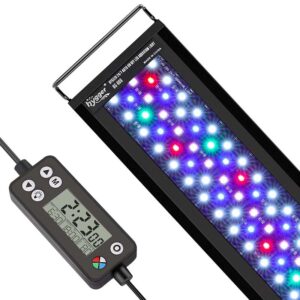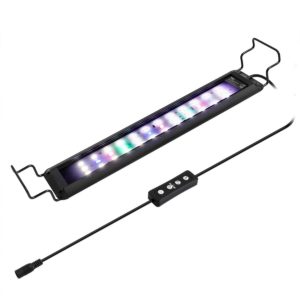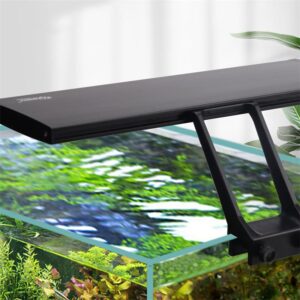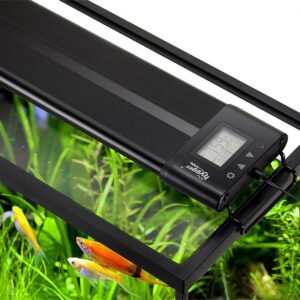Setting up LED lighting needs two essential metrics, which are Kelvin and Lumens, but especially for aquariums and interior design. These metrics establish the brightness level of an LED light and define its light color temperature. Your success in selecting LED lighting depends on knowing these specifications, i.e., the Kelvin meaning in lighting. This article explains how Kelvin and Lumens influence lighting in fish tanks and beyond through detailed explanations of their principles and functions.
Content Table
What Is Kelvin in Lighting?
Kelvin acts as the standard measure to describe the color temperature of lighting devices. Kelvin measures how warm or cool a light looks. LED light users depend on Kelvin to explain how the light feels warm or cool to the eye. Light appears warmer at lower Kelvin numbers since it shows more red and yellow tones, whereas it looks cooler at higher numbers, which produce more white and blue tones.
For example:
- A candle emits light at about 1500K, which is very warm.
- A cloudy sky can emit light upwards of 6500K, which is cool white or even blueish.
In LED lighting, especially for indoor use and aquariums, choosing the right Kelvin level is crucial because it influences mood, visibility, and even biological processes in plants and aquatic life.

kelvin meaning
Different Kelvin Values
LED lights come in a range of Kelvin values to suit different purposes. Here’s a breakdown:
- 2700K – 3000K (Warm White):
- Best for living rooms, bedrooms, and cozy environments.
- Produces a soft, warm glow similar to incandescent bulbs.
- Not ideal for detail work or aquarium lighting.
- 3500K – 5000K (Neutral White to Cool White):
- Great for kitchens, offices, and bathrooms.
- Brighter and more alerting than warm light.
- Suitable for freshwater aquariums where clarity is needed.
- 6000K – 10000K (Daylight to Bright White):
- Mimics daylight; appears crisp and blue-white.
- Ideal for planted aquariums and reef tanks where light penetration is important.
- Stimulates plant photosynthesis and coral growth.
- 10000K – 16000K (Blue-White to Actinic Blue):
- Often used in marine aquariums.
- Enhances the colors of coral and saltwater fish.
- Too cold for general residential use but perfect for deep-water setups.

kelvin in lighting
Optimal Kelvin for LED Fish Tank Lighting
The ideal Kelvin value for fish tank lighting depends on the type of aquarium:
- Freshwater Tanks (non-planted): These lights show through better into the water and improve fish hues, but do not spur too much algae growth. This light range mirrors daylight to amplify fish colors in decorative fish and work with their habitat environment.
- Freshwater Planted Tanks: Plant tissues receive the proper sunshine levels to develop strong roots and leaves. Plants in an aquarium need this light range to perform photosynthesis, which increases their growth and produces oxygen to improve water clarity.
- Saltwater Tanks with Fish Only: This lighting produces attractive colors for your saltwater fish species to enhance your viewing experience. The intense blue rays replicate underwater ocean depths and produce striking lighting that makes marine fish species shine brilliantly.
- Reef Tanks (Coral): The blue-spectrum lighting matches natural reef conditions while allowing corals to use light for photosynthesis. Coral growth and vibrant visual display increase when they receive light from this specific spectrum range. This lighting is essential for keeping photosynthetic Zoanthids, Acropora, and LPS coral species alive.
What Are Lumens in Lighting?
Lumens (lm) measure the total amount of visible light emitted by a source. While Kelvin tells you the color of the light, Lumens tell you how bright the light appears to the human eye.
For example:
- A standard 60-watt incandescent bulb emits about 800 lumens.
- An LED light that emits 1600 lumens is twice as bright.
The selection of perfect Lumen levels lets you achieve proper lighting while avoiding a lack or excessive extremes across your tank and room. When the light intensity from the bulb is too weak or too strong, it impairs your view of the tank and harms the fish either way. A planted tank needs 20 to 40 lumens per liter of water to support healthy plant growth through photosynthesis. Match the lighting output to your aquarium size and depth to keep the environment healthy.

how many lumens
How Much Power LEDs Consume About Lumens
One major advantage of LED lights is their energy efficiency. LEDs produce more lumens per watt than traditional bulbs, meaning brighter light at lower power consumption.
Here’s a quick reference:
- 8–12 watts LED= ~800 lumens (like a 60W incandescent)
- 13–18 watts LED= ~1100 lumens (like a 75W incandescent)
- 20–25 watts LED= ~1600 lumens (like a 100W incandescent)
In fish tanks, this becomes important. You want high output to support plant or coral growth without spiking your electricity bill. Modern aquarium LEDs offer 100+ lumens per watt, making them both effective and eco-friendly.
Lumen Vs Kelvin – What Are Their Differences?
| Feature | Lumen | Kelvin |
| Definition | Measures total brightness (visible light output) | Measures color temperature (light appearance) |
| Unit Symbol | lm | K |
| Focus | Brightness | Light color (warm, neutral, or cool tones) |
| Range Examples | 200 lm (dim) to 5000+ lm (very bright) | 2700K (warm) to 20000K (very cool/blue) |
| What It Affects | How well an area is illuminated | The mood or appearance of the light |
| Human Perception | Determines how bright light feels | Determines whether light feels warm or cool |
| Importance in Aquariums | A 1600-lumen bulb for reading or tank illumination | Helps replicate natural lighting conditions for aquatic life |
| Example Use | A 1600-lumen bulb for reading or tank illumination | 6500K for freshwater planted tanks, 14000K for reef tanks |
| Adjustability | Usually fixed or dimmable with hardware | Often adjustable in tunable LED systems |
| Misconception | Higher lumens = better (not always true) | Higher Kelvin = brighter (not necessarily true) |
The Correlation Between Lumen and Kelvin
Even though Lumens and Kelvin values do not change each other directly, their impact flows indirectly. Typically:
- A light source that produces cooler light at equal wattage tends to appear brighter to our eyes because they detect blue-white light better.
- The same Lumen output could make a warm white light appear dimmer because of its reduced brightness.
Knowing both lumens and Kelvin helps you select lighting that creates good vision and a pleasing aesthetic, although they work separately.
What Is Important When Buying an LED Light for a Fish Tank, Kelvin or Lumen?
The short answer: Both matter, but for different reasons.
- Use Kelvin to determine color temperature based on the aquarium type:
- Freshwater = 6500K–8000K
- Saltwater = 10000K–20000K
- Use Lumens to ensure brightness is adequate:
- For fish-only tanks: 20–40 lumens per liter
- For planted tanks: 40–60 lumens per liter
- For reef tanks: 50–80 lumens per liter
In short, Kelvin affects your tank’s appearance and biological processes, while Lumens ensure sufficient light reaches every corner.

lumens lighting
Parting Thoughts
Selecting an LED light system for aquarium use demands knowing the importance of both Kelvin and Lumens values. Kelvin enables suitable lighting settings that enhance plant growth and protect living beings in water. LED lights compare direct brightness levels to prevent energy waste.
When shopping for LED lights:
- Pay attention to both Kelvin (for color) and Lumens (for brightness).
- Match the specs to the needs of your environment, whether it’s a peaceful freshwater tank or a vibrant coral reef.
Understanding these two key concepts transforms your approach to lighting, giving you not only a visually stunning setup but also a healthy, thriving ecosystem.




Leave a comment